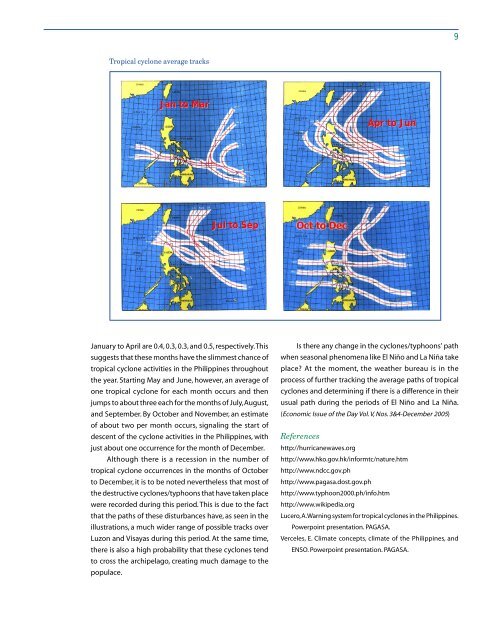Read More - Philippine Institute for Development Studies
Read More - Philippine Institute for Development Studies
Read More - Philippine Institute for Development Studies
Create successful ePaper yourself
Turn your PDF publications into a flip-book with our unique Google optimized e-Paper software.
9<br />
Tropical cyclone average tracks<br />
Jan to Mar<br />
Apr to Jun<br />
Jul to Sep<br />
January to April are 0.4, 0.3, 0.3, and 0.5, respectively. This<br />
suggests that these months have the slimmest chance of<br />
tropical cyclone activities in the <strong>Philippine</strong>s throughout<br />
the year. Starting May and June, however, an average of<br />
one tropical cyclone <strong>for</strong> each month occurs and then<br />
jumps to about three each <strong>for</strong> the months of July, August,<br />
and September. By October and November, an estimate<br />
of about two per month occurs, signaling the start of<br />
descent of the cyclone activities in the <strong>Philippine</strong>s, with<br />
just about one occurrence <strong>for</strong> the month of December.<br />
Although there is a recession in the number of<br />
tropical cyclone occurrences in the months of October<br />
to December, it is to be noted nevertheless that most of<br />
the destructive cyclones/typhoons that have taken place<br />
were recorded during this period. This is due to the fact<br />
that the paths of these disturbances have, as seen in the<br />
illustrations, a much wider range of possible tracks over<br />
Luzon and Visayas during this period. At the same time,<br />
there is also a high probability that these cyclones tend<br />
to cross the archipelago, creating much damage to the<br />
populace.<br />
Is there any change in the cyclones/typhoons' path<br />
when seasonal phenomena like El Niño and La Niña take<br />
place At the moment, the weather bureau is in the<br />
process of further tracking the average paths of tropical<br />
cyclones and determining if there is a difference in their<br />
usual path during the periods of El Niño and La Niña.<br />
(Economic Issue of the Day Vol. V, Nos. 3&4-December 2005)<br />
References<br />
http://hurricanewaves.org<br />
http://www.hko.gov.hk/in<strong>for</strong>mtc/nature.htm<br />
http://www.ndcc.gov.ph<br />
http://www.pagasa.dost.gov.ph<br />
http://www.typhoon2000.ph/info.htm<br />
http://www.wikipedia.org<br />
Lucero, A. Warning system <strong>for</strong> tropical cyclones in the <strong>Philippine</strong>s.<br />
Powerpoint presentation. PAGASA.<br />
Verceles, E. Climate concepts, climate of the <strong>Philippine</strong>s, and<br />
ENSO. Powerpoint presentation. PAGASA.










